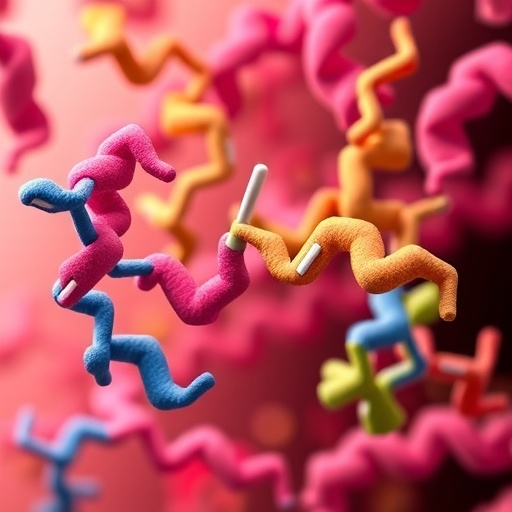In the intricate landscape of neurobiology, the relationship between oxidative stress and neurodegenerative diseases remains a focal point of research, particularly in the context of Parkinson’s disease (PD). A groundbreaking study led by researchers Danielyan, Karapetyan, and Simonyan has uncovered the concentration-dependent effects of bacterial melanin on the neurotoxic outcomes associated with rotenone exposure. Rotenone, a well-documented neurotoxin, has been instrumental in creating rodent models that mimic the motor dysfunction and neurodegenerative characteristics akin to those seen in PD. The study provides insightful revelations that could inform future therapeutic strategies.
Bacterial melanin—previously noted for its protective properties against environmental stressors—has now been implicated as a pivotal player in modulating oxidative responses in neurological tissues. The study meticulously analyzed the interaction between various concentrations of melanin and superoxide production in rat tissues exposed to rotenone. The research methodology involved assessing both the behavioral outcomes in the rat model and the biochemical markers indicative of oxidative stress. This dual approach enriched the quality of data and facilitated a comprehensive understanding of melanin’s role.
One of the most striking findings of this research is the duality of bacterial melanin’s effects on neuronal tissues. At lower concentrations, melanin appears to confer neuroprotection, act as a scavenger of free radicals, and reduce superoxide levels. By neutralizing these harmful oxidative agents, melanin seems to safeguard dopaminergic neurons from degeneration. This neuroprotective effect is significant given that oxidative stress is a major contributor to neuronal death in Parkinson’s disease. Therefore, the exploration of bacterial melanin as a potential therapeutic agent appears promising.
Conversely, the study also identified that at higher concentrations, bacterial melanin may paradoxically exacerbate oxidative stress. This delineation suggests a complex interplay where melanin concentrations must be finely tuned to ensure optimal therapeutic benefits. This finding serves as a crucial reminder that biocomponents perceived as entirely beneficial may exhibit dose-dependent adverse effects. The implications for treatment regimens in Parkinson’s disease could be profound, emphasizing the importance of customized approaches tailored to individual patient profiles.
The research utilized state-of-the-art biochemical assays to quantify superoxide levels in the rat tissues, facilitating an understanding of how melanin influences oxidative pathways. Employing spectrophotometric techniques, the team measured biomarker levels to gauge the extent of oxidative damage and neuronal viability. These measurements are foundational in the pharmacological assessment of potential new therapeutic agents and bring robust scientific rigor to the study.
Furthermore, the findings lend credence to the notion that bacterial metabolites can be valuable allies in the quest to combat neurodegeneration. The role of the gut microbiome in neurodegenerative diseases has recently garnered much attention, highlighting the potential of utilizing microbial products in treatment strategies. This research not only furthers that dialogue but also opens new avenues for exploration into how other microbial extracts might offer similar or complementary benefits.
The elucidation of melanin’s role within the context of rotenone-induced toxicity also underscores the utility of animal models in neuropharmacology. While animal studies often bear the burden of ethical considerations, they undeniably serve as vital platforms from which fundamental biological insights can be derived. The predictive strength of these models in understanding human disease pathology remains indispensable in the pharmaceutical industry’s relentless pursuit of new drug discoveries.
Additionally, the study’s consideration of therapeutic windows brings philosophical considerations into the scientific discourse. As we embark on this journey of understanding neurodegenerative diseases, the dialogues surrounding precision medicine are not merely academic. They reflect a growing consensus that one-size-fits-all solutions are the antithesis of effective therapy. Each patient’s unique biochemical environment must be accounted for to develop successful interventions.
While the connection between oxidative stress and neuronal pathology is well-established, the introduction of bacterial melanin as a modulator enriches the narrative. By providing a tangible link between microbial biology and neuroprotection, this research invites further studies that might unveil additional microbial-derived compounds capable of influencing neuronal health. The interplay between our microbiome and neurological wellness is a frontier awaiting exploration, and the implications could be groundbreaking.
The study highlights several critical takeaways from a clinical perspective. For one, the therapeutic potential of microbial products like melanin necessitates rigorous clinical trials before practical applications are developed. Researchers must ensure consistent quality and efficacy across varied concentrations while carefully managing dosage to balance beneficial and detrimental effects. This rigorous process ensures that any prospective therapies designed based on this scientific knowledge will prioritize patient safety and efficacy.
Moreover, the narrative surrounding bacterial melanin could catalyze a broader shift in how researchers consider non-traditional biochemical entities in neuropharmacology. The concept of harnessing microbial products for therapeutic insights enriches our understanding of human health and diseases. As researchers continue to delve into the complexities of our microbiota, the opportunity to uncover novel interactions that directly influence neurodegenerative processes presents itself as a rich area for scientific inquiry.
In conclusion, the research conducted by Danielyan et al. marks a pivotal juncture in our understanding of the intricate dynamics between bacterial metabolites and neurodegeneration. By revealing the concentration-dependent effects of bacterial melanin on oxidative stress pathways, the study lays down a framework for future investigations aimed at harnessing the neuroprotective properties of microbial compounds. As we strive toward innovative and efficacious treatments for Parkinson’s disease, insights gained from this research will undoubtedly illuminate the path forward.
It is clear that while challenges remain in deciphering the full extent of these relationships, the burgeoning field of neuropharmacology stands to benefit immensely from integrative research that crosses traditional disciplinary boundaries. By fostering interdisciplinary collaboration, embracing novel therapeutic modalities, and prioritizing patient-centric approaches, we may soon witness advancements that transform the landscape of neurodegenerative disease management.
Subject of Research: The concentration-dependent effects of bacterial melanin on superoxide production in rat tissues, specifically in the context of Parkinson’s disease.
Article Title: Concentration-dependent effects of bacterial melanin on new superoxide-producing associates in rat tissues: a rotenone neurotoxic model of Parkinson’s disease.
Article References: Danielyan, M., Karapetyan, K., Simonyan, R. et al. Concentration-dependent effects of bacterial melanin on new superoxide-producing associates in rat tissues: a rotenone neurotoxic model of Parkinson’s disease. BMC Pharmacol Toxicol 26, 172 (2025). https://doi.org/10.1186/s40360-025-00989-x
Image Credits: AI Generated
DOI: 10.1186/s40360-025-00989-x
Keywords: Parkinson’s disease, bacterial melanin, oxidative stress, rotenone, neuropharmacology, neurodegeneration.
Tags: bacterial melaninbiochemical markers of oxidative stressdual effects of bacterial melaninenvironmental stressors and neuroprotectionneurobiology research advancementsneuroprotective properties of melaninoxidative stress and neurodegenerationParkinson’s disease neurotoxicityrodent models of Parkinson’srotenone exposure effectssuperoxide production in neuronstherapeutic strategies for Parkinson’s




